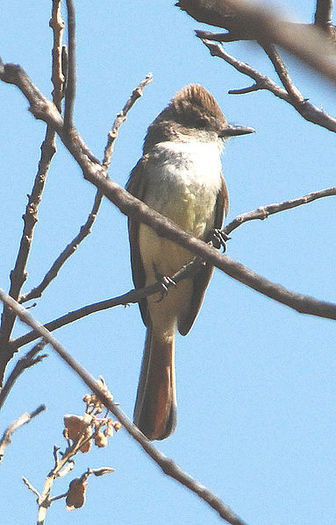Nutting's flycatcher
The nest is built in a tree cavity or similar natural or man-made hole, and the normal clutch is three to five eggs.

Original source: Jerry OldenettelPermission(Reusing this file)This image, which was originally posted to Flickr.com, was uploaded to Commons using Flickr upload bot on 23:13, 13 April 2008 (UTC) by Ltshears (talk). On that date it was licensed under the license below. This file is licensed under the Creative Commons Attribution-Share Alike 2.0 Generic license.You are free:to share – to copy, distribute and transmit the work
Author: Jerry OldenettelPermission(Reusing this file)This image, which was originally posted to Flickr.com, was uploaded to Commons using Flickr upload bot on 23:13, 13 April 2008 (UTC) by Ltshears (talk). On that date it was licensed under the license below. This file is licensed under the Creative Commons Attribution-Share Alike 2.0 Generic license.You are free:to share – to copy, distribute and transmit the work
The Nutting's flycatcher is classified as Least Concern. Does not qualify for a more at risk category. Widespread and abundant taxa are included in this category.
and leaves in the way! Nutting's Flycatcher (Myiarchus nuttingi) has a smaller bill, browner face, and slightly different undertail pattern than Brown-crested Flycatcher (M. tyrannulus). Nutting's is best told from Ash-throated Flycatcher (M. cinerascens) by voice, so fortunately we obtained some video with audio that helps make this distinction. Dusky-capped Flycatcher (M. tuberculifer) also has a small bill, but much less rufous in the tail and a very distinctively different, plaintive call-note. More
Alvaro Jaramillo that include Nutting's Flycatchers in Mexico. I am personally unable to access those files (no broadband at home, no sound card at work) but those who can do so have found them useful. Words are a difficult tool to use to describe vocalizations, and most everyone will use different words for the same calls. More
A probable Nutting's Flycatcher in southwestern New Mexico. West. Birds 9:135-136. More
A PROBABLE NUTTING'S FLYCATCHER IN SOUTHWESTERN NEW MEXICO ZIMMERMAN, DALE A. DALE A. ZIMMERMAN, Department of Biological Science, Western New Mexico University, Silver City, New Mexico 88061 Early in the afternoon of 18 December 1976 Marian Zimmerman and I closely observed a Myiarchus flycatcher, which we believe was a Nutting's Flycatcher (M. nuttingi), in the Gila River Valley, approximately 10 km downstream from Riverside, Grant County, New Mexico. More
Nutting's Flycatcher, Myiarchus nuttingi, is a passerine bird in the tyrant flycatcher family. It breeds in semi-arid desert scrub and tropical deciduous forest from western Mexico to northwest Costa Rica. It is normally a year round resident, however has been known as an occasional vagrant to southern California and southern Arizona–(the Madrean sky islands region), in the United States. The nest is built in a tree cavity or similar natural or man-made hole, and the normal clutch is three to five eggs. More
This is the second Nutting's Flycatcher I have seen. The first was at Lake Patagonia in Arizona. I have posted some notes and useful links about that bird here. This is the first record of Nutting's Flycatcher for California. More information, including some wonderful photos of the spread tail, directions and maps to the area are available here. Andy Birch has posted some wonderful sketches here and Don Roberson's account and photos are here. More
trip to Arizona in search of the Nutting's Flycatcher which has been at Lake Patagonia State Park since it was discovered December 14, 1997. I arrived around 9:30 and spent about two hours searching the mesquite groves at the east end of the lake without success. I met several other birders including Betty Burridge and Michael Ruggles of Santa Rosa, California. More
* Nutting's Flycatcher - "Typical" calls, Sonora, Mexico More
Nutting's Flycatcher: Song is a sharp, chattering "wheep, wheep" or "wheek, wheek." Call is a repetitious "ki, di-di-dir." Similar Species Nutting's Flycatcher: Ash-throated Flycatcher is gray-brown overall, has paler yellow belly, pale gray throat and breast, and different voice. . Home | Search | Browser | Expert | Forum | Store | My Whatbird | Help | Site Map © 2002 - 2007 www.whatbird.com All rights reserved. More
Nutting's Flycatcher: Native of Mexico; accidental in southeastern Arizona. Frequents interiors and edges of deciduous woodlots; also occurs in second-growth, from low to middle levels. Listen to Call Voice Text "wheep, wheep", "wheek, wheek", "ki, di-di-dir" Interesting Facts * The Nutting's Flycatcher was named after zoologist Charles Cleveland Nutting. More
The Nutting's Flycatcher is native to Northwestern Mexico and south to Costa Rica. Only four sightings of the Nutting's Flycatcher have been recorded in the United States, and this particular photo was taken by Bruce Barrett in the Santa Cruz area (1/04/03). The Nutting's is a cavity nester, laying three to five eggs, often choosing a knot hole or secluded cavity 20 to 50 feet above ground. At least one member of each pair may return to the same nest site each year. More
Nutting's Flycatcher, Santa Cruz CA Brown Booby, Half Moon Bay, CA Black Skimmer, Martinez CA Sage Thrasher, Davis CA Cape May Warbler, Sacramento, CA Costa's Hummingbird, Stinson Beach Pinyon Jay, San Benito Mountain Broad-billed Hummingbird, Sonoma Anhinga, Imperial County, CA 28 December 2003 Snow Bunting,Clifton Court Forebay, Contra Costa County 6 March 2004 Grace's Warbler, Chimney Peak Campground, Tulare County, California 31 May 2004 Common Eider, Crescent City, California, 10 July 2004 Long-tailed Duck, O'Neill Forebay, 29 December 2004 Yellow-bellied Sapsucker, Kern More
Nutting's Flycatcher, Mason Regional Park, Orange Co, California 27th December 2000 © Dan Lockshaw This is North America's third record and California's first of this Mexican species. - Round-Up by Cin-Ty Lee Photographs by Julian Hough, Dennis Malueg, Dan Lockshaw,(Dan's Owl Website) Scott Spangenberg (Scott's website) Winters in the northeast this month finally returned to normal snowy and cold! However, the birds sure werent normal. More
Family : Tyrannidae
Genus : Myiarchus
Species : nuttingi
Authority : Ridgway, 1882

